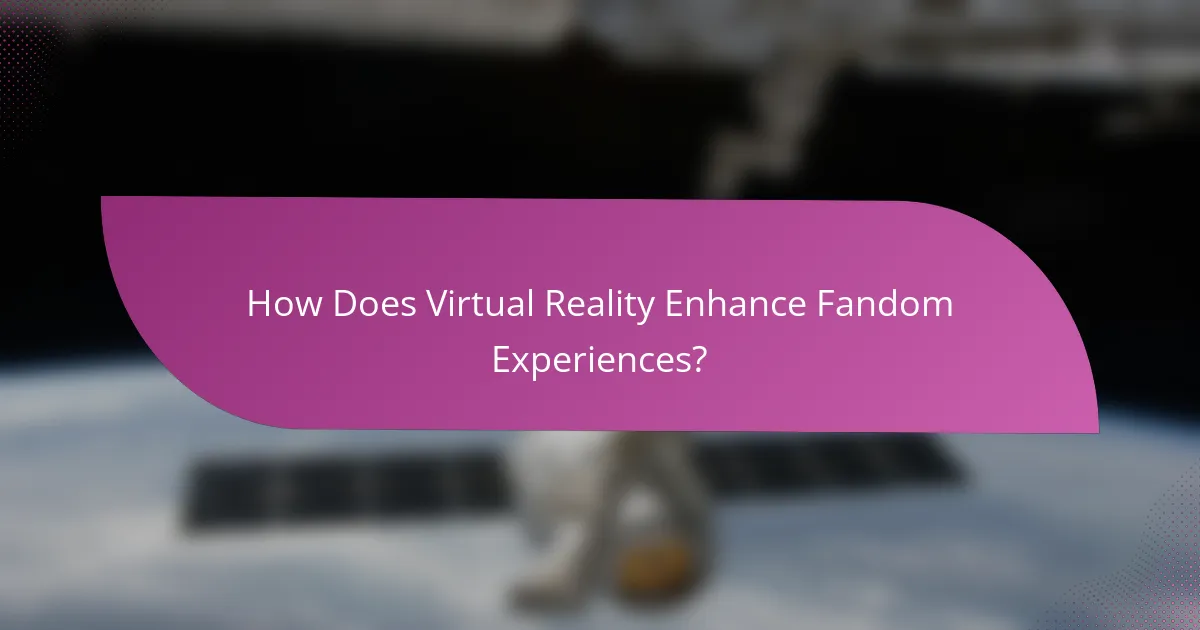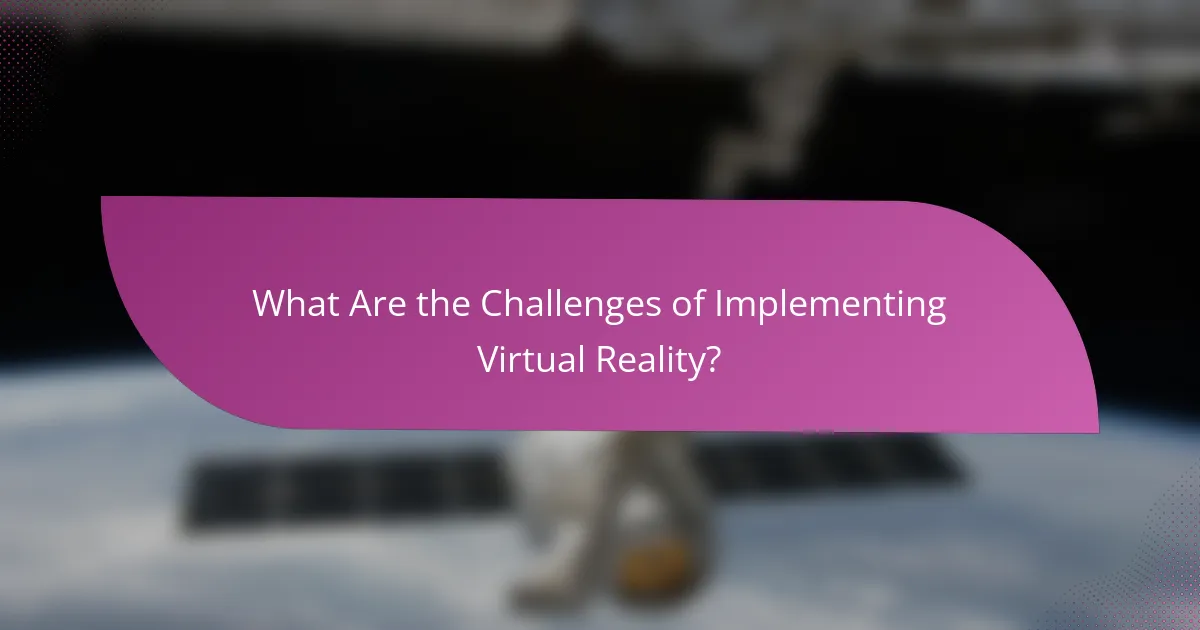Virtual reality (VR) revolutionizes fandom experiences by immersing fans in interactive environments where their favorite stories and characters come to life. This technology fosters deeper engagement through unique storytelling and community interactions, offering memorable experiences that surpass traditional media. With various platforms available, fans can choose the VR experience that best aligns with their interests and budget, enhancing their connection to the content they love.

How Does Virtual Reality Enhance Fandom Experiences?
Virtual reality (VR) significantly enhances fandom experiences by immersing fans in interactive environments that bring their favorite stories and characters to life. This technology allows for deeper engagement through storytelling, events, and community interactions, creating memorable experiences that traditional media cannot match.
Immersive storytelling
Immersive storytelling in VR allows fans to step inside their favorite narratives, experiencing plots and characters in a three-dimensional space. By using VR headsets, users can explore detailed worlds, interact with elements, and even influence story outcomes, making them feel like active participants rather than passive viewers.
This form of storytelling often incorporates audio-visual elements that enhance emotional connections. For example, fans of fantasy series can walk through enchanted forests or battle alongside heroes, creating a personal connection to the story that traditional media lacks.
Interactive fan events
VR enables interactive fan events that can be attended from anywhere, breaking geographical barriers. These events often include live performances, Q&A sessions, and exclusive content reveals, allowing fans to engage directly with creators and fellow enthusiasts.
For instance, a popular comic convention might host a virtual reality panel where fans can ask questions in real-time, participate in polls, or even join in on discussions, making the experience more engaging than watching a livestream.
Virtual meet-and-greets
Virtual meet-and-greets provide fans with the opportunity to interact with their favorite celebrities or creators in a more personal setting. Through VR, fans can have one-on-one conversations, take virtual selfies, and receive personalized messages, enhancing the connection between fans and their idols.
These meet-and-greets can be organized as limited-time events, often requiring tickets priced in the range of $20 to $100, depending on the celebrity’s popularity. This accessibility allows more fans to participate compared to traditional in-person events.
Community engagement platforms
Community engagement platforms in VR foster connections among fans, allowing them to share experiences, create content, and collaborate on projects. These platforms often include forums, virtual hangouts, and collaborative spaces where fans can meet and interact in real-time.
For example, a VR platform dedicated to a specific fandom might host regular themed events where fans can showcase their artwork, discuss theories, or even participate in fan-made games. This sense of community enhances the overall fandom experience, making it more inclusive and interactive.

What Are Popular Virtual Reality Platforms for Fans?
Popular virtual reality platforms for fans include devices that provide immersive experiences tailored to gaming, social interaction, and fandom engagement. These platforms vary in terms of hardware requirements, content availability, and user experience, making it essential for fans to choose one that aligns with their interests and budget.
Oculus Quest 2
The Oculus Quest 2 is a standalone VR headset that offers a wireless experience, making it highly accessible for fans. It features a library of games and experiences, including popular titles and social applications, which can be enjoyed without the need for a powerful gaming PC.
With a price point typically around $300, it provides a good balance of performance and affordability. Users should consider the storage options available, as they can range from 64GB to 256GB, affecting the number of games and experiences that can be stored.
PlayStation VR
PlayStation VR is designed for use with the PlayStation 4 and PlayStation 5 consoles, making it a great option for fans already invested in the PlayStation ecosystem. It offers a variety of exclusive titles and experiences that leverage the console’s capabilities.
Pricing for the PlayStation VR headset is generally around $400, but it may require additional accessories for the best experience. Fans should ensure they have the necessary PlayStation Camera and Move controllers for optimal gameplay.
HTC Vive
The HTC Vive is known for its high-quality visuals and room-scale tracking, making it ideal for immersive gaming experiences. It requires a powerful gaming PC and external sensors for tracking, which can complicate setup but enhances the overall experience.
Typically priced between $500 and $800, the HTC Vive offers a premium experience with a strong library of VR content. Fans should be prepared for a more complex installation process and ensure they have adequate space for movement.
Valve Index
The Valve Index is a high-end VR system that delivers exceptional graphics and a wide field of view. It is compatible with SteamVR, giving fans access to a vast library of VR games and experiences.
With a price tag around $1,000, it is one of the more expensive options, but it offers advanced features such as finger tracking controllers and high refresh rates. Fans should assess their budget and PC specifications before investing in this platform to ensure compatibility and performance.

How Can Brands Leverage Virtual Reality for Fan Engagement?
Brands can leverage virtual reality (VR) to enhance fan engagement by creating immersive experiences that captivate audiences and foster deeper connections. By utilizing VR technology, brands can offer unique interactions that traditional media cannot match, ultimately driving loyalty and community among fans.
Branded virtual worlds
Branded virtual worlds allow fans to explore environments that reflect a brand’s identity and values. These immersive spaces can host events, showcase products, or provide interactive storytelling experiences. For example, a sports brand might create a virtual stadium where fans can meet players, attend live games, or participate in training sessions.
When designing a branded virtual world, consider user experience and accessibility. Ensure that the environment is engaging and easy to navigate, accommodating various skill levels and VR platforms. Regular updates and events can keep the virtual space dynamic and encourage repeat visits.
Exclusive VR content
Offering exclusive VR content is an effective way to entice fans and create a sense of belonging. This can include behind-the-scenes footage, virtual meet-and-greets with celebrities, or unique gameplay experiences in a gaming context. Such content can be monetized or offered as rewards for loyal customers.
To maximize impact, brands should promote this exclusive content through their existing channels, such as social media or email newsletters. Highlighting the limited availability can create urgency and encourage fans to engage quickly.
Gamified experiences
Gamified experiences incorporate game-like elements into fan engagement strategies, making interactions more enjoyable and rewarding. Brands can create challenges, competitions, or loyalty programs that utilize VR to enhance participation. For instance, a movie studio might develop a VR scavenger hunt related to a film’s plot, encouraging fans to explore and interact with the story.
When implementing gamification, focus on clear objectives and rewards that resonate with your audience. Avoid overly complex mechanics that could frustrate users. Simple, achievable goals can lead to higher engagement and satisfaction among fans.

What Are the Benefits of Virtual Reality in Fandom?
Virtual reality (VR) enhances fandom experiences by creating immersive environments that foster deeper engagement and connection with content. Fans can interact with their favorite franchises in ways that traditional media cannot offer, leading to increased loyalty and emotional ties.
Increased fan loyalty
Virtual reality can significantly boost fan loyalty by providing unique experiences that are exclusive to VR platforms. Fans who engage in VR environments often feel a stronger sense of belonging and attachment to the franchise, as they can explore worlds and narratives in a more personal way.
For example, VR events such as live concerts or interactive storytelling sessions allow fans to feel like active participants rather than passive viewers. This participatory aspect can lead to a more committed fan base, as users are more likely to support franchises that offer such engaging experiences.
Enhanced emotional connection
VR fosters a deeper emotional connection between fans and their favorite characters or stories. By immersing users in a 360-degree environment, VR allows fans to experience narratives from a first-person perspective, making them feel as if they are part of the story.
This emotional engagement can be particularly powerful in genres like horror or fantasy, where the immersive nature of VR amplifies feelings of excitement or fear. Fans often report heightened emotional responses when they can interact with beloved characters and settings in a virtual space.
Broader audience reach
Virtual reality has the potential to reach a wider audience by appealing to diverse demographics and interests. With the increasing accessibility of VR technology, more fans can participate in immersive experiences, regardless of their geographical location.
For instance, franchises can host global VR events that allow fans from different countries to connect and interact in real-time. This not only expands the fan base but also creates opportunities for cross-cultural engagement, enriching the overall fandom experience.

What Are the Challenges of Implementing Virtual Reality?
Implementing virtual reality (VR) presents several challenges that can hinder its widespread adoption. Key issues include high development costs, technical limitations of current hardware, and user accessibility concerns that affect diverse demographics.
High development costs
The financial investment required to develop VR experiences can be substantial. Costs typically range from tens of thousands to millions of dollars, depending on the complexity and scale of the project. This includes expenses for software development, hardware procurement, and ongoing maintenance.
To mitigate these costs, companies can consider using existing platforms or engines, such as Unity or Unreal Engine, which may reduce development time and expenses. Collaborating with established VR studios can also help share the financial burden.
Technical limitations
Current VR technology faces several technical limitations, including hardware constraints like processing power, resolution, and latency. Many VR systems still struggle with motion sickness due to high latency, which can detract from user experience.
Developers should prioritize optimizing performance and ensuring compatibility across various devices. Staying updated with the latest advancements in VR technology can help address these limitations and improve overall user engagement.
User accessibility issues
Accessibility is a significant challenge in VR, as not all users can easily engage with the technology. Factors such as physical disabilities, age, and economic status can limit access to VR experiences, particularly in regions with less technological infrastructure.
To enhance accessibility, developers should consider creating adaptive interfaces and providing options for different input methods. Offering affordable VR solutions or utilizing mobile platforms can also help reach a broader audience.

How to Choose the Right VR Experience for Your Fandom?
Selecting the right VR experience for your fandom involves understanding your interests and the type of engagement you seek. Consider factors like content quality, interactivity, and community involvement to find an experience that resonates with your passion.
Identify target audience
Understanding your target audience is crucial when choosing a VR experience. Different fandoms attract varied demographics, including age, interests, and engagement levels. For instance, a younger audience may prefer fast-paced, interactive experiences, while older fans might appreciate narrative-driven content.
Consider conducting surveys or engaging with community forums to gather insights about what potential users value in a VR experience. This feedback can guide your choice, ensuring the selected experience aligns with the preferences and expectations of your fandom.
Additionally, look at existing VR experiences within your fandom to identify trends. Popular titles often reflect the interests of their audience, so analyzing these can help you understand what works well and what doesn’t.
